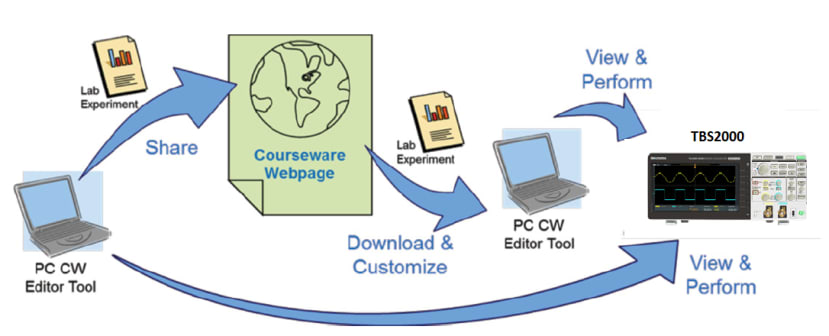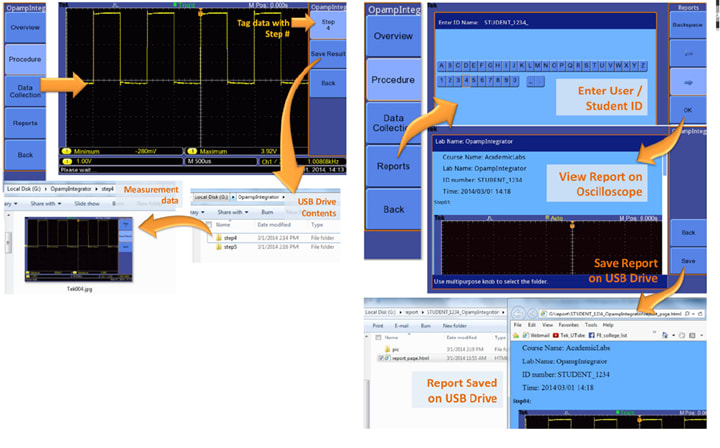Clever Ways to Create, Run and Grade Education Lab Courses
Follow articleHow do you feel about this article? Help us to provide better content for you.
Thank you! Your feedback has been received.
There was a problem submitting your feedback, please try again later.
What do you think of this article?
Hello again!
My names is Lee Morgan and I’m a business development manager for IoT and Power applications at Tektronix. I’m spending the month as a visiting blogger on DesignSpark. Last week I spent some time outline my vision of what the teaching lab of tomorrow would look like and how Tektronix is quickly giving institutions the tools they need to realize this, today. This week I wanted to focus on a subplot to this topic – the generation of course content. Laboratory classes are an integral part of any electronic engineering curriculum. They enable students to hone hands-on skills by exploring the theoretical concepts taught in the classrooms. The lab experiments also help student to extend their knowledge by applying concepts to real life applications. The faculty play a key role in developing, conducting and evaluating these lab sessions.
Key Challenges Faced In Lab Course Development and Deployment
Independent research into the key challenges faced by educators and students in universities found that there was a significant opportunity to improve the lab experience by putting a standardize framework around a lab’s workflow. The survey revealed that the process of designing and creating a new lab experiment is the biggest challenged faced by educators. On top of this maintaining courses and keeping them up to date can also be time consuming – when a lab gets upgraded the educator must update all his course material for the new equipment. Some of the other major challenges are preparing multiple manuals for each lab bench or student, conducting the lab class itself, ensuring clarity of the instructions to the students and collecting and grading the results at the end of the lab, to name but a few. Fig 1 shows the typical workflow around the development and deployment of laboratory classes within a university syllabus. First, the lecturer must create the experiments and validate the procedures. As mentioned above, this is often the most time consuming section. Then they must create and distribute lab manuals containing information on the objectives, equipment lists, theory and procedure to complete the exercise. This manual usually outlines how and what information the instructor wants the student to produce at the end of the session. Next they must conduct the classes itself and collect the results. Finally they must grade and report the results of each student’s work.
On the student’s side, they must collect their measurement results, sketch or gather screenshots of plots, and generate lab reports documenting their activities. These reports rarely have a consistent format making the review and grading process more difficult.
Fig 1 – Typical University Workflow for Engineering Laboratory Classes
Enabling Efficient Lab Courseware Management
At Tektronix, we offer a range of tools and instruments that help with the development and distribution of course content. Tektronix’s latest education scope, the TBS2000, and Courseware ecosystem, allows the professor to quickly create lab experiments and efficiently distribute them to each workstation in the lab. For the students, they get a detailed step-by-step instructions including diagrams and photos around the experiments. It also gives them the means to automatically create a standardized report and push this back to the professor. Not only that, but Tektronix has also created and maintains a free, web-based, multi-lingual community platform for sharing lab courseware. Educators can browse and download complete courses for reuse or inspiration. Tektronix Courseware has three simple step – create, run and collect. Fig 2 shows the conceptual idea around the Courseware ecosystem.
Fig 2 – Courseware Ecosystem
Create the Course Material
The first step in any new lab experiment is to design it and create the detailed instructions. This is also the most time consuming. Tektronix Courseware supplies a PC Editor tool that standardizes the lab format, including powerful editing features. This Windows interface makes it easy to insert text descriptions and instructions, and insert images, tables, and equations. The free software tool can used by everyone in the faculty, making it easy to share material and standardize the lab format across the institution. This allows the faculty to set and ensure its own standard level of work for course material, improving productivity and the students’ learning outcomes.
Fig 3 – Courseware Editor Tool for PCs
Courseware organizes the Lab into two basic sections. The first is an overview section, which is a free form area where any type of information can be included on the objectives, theory and equipment in relation to the experiment. Tips, ticks and bottlenecks can all be detailed and updated in this section. The second area is the procedure section, which gives a structured format to allow the educator to deliver step-by-step instructions on completing the experiment and on documenting the results.
Alternatively, educators can utilize the ever growing online Courseware community. Your peers have loaded nearly 700 different course, many of which in different languages to English. You’re welcome to browse and download different courses, or to contribute to this community by uploading your own Courseware material.
Running Your Courseware Lab
Once the material for a lab has been created, it can then be instantly distributed and loaded onto every TBS2000 in the Lab. If your lab utilizes TekSmartLab, you can update up to 100 lab stations with the single click of a button! For other labs you can simply update each scope using a USB thumb drive. Each TBS2000 can hold up to eight courses, and each course can contain thirty or more individual exercises or labs. The exercises now becomes a set of embedded menus in the TBS2000 scope using interface, as shown in Fig 4.
Fig 4 – View of the Courseware Material on the TBS2000 Oscilloscope
Since the lab is distributed electronically it can alleviate the need for paper lab manuals, which need to be produced for each student, each year. If a particular lab needs updating it can be simply done through the Editor and TekSmartLab features.
Data Collection and Report Generation
The final stage of a lab experience is for the student to document their findings and create a conclusive, legible report for the professor. I’ve already mentioned the waste involved with paper lab books, but if the exercise is whittled down to filling in boxes or tables with results, this may not necessarily reflect the student’s true understanding of the exercise. If a drawing or plots are required, students may resort to duplicating waveforms by hand which may be unnecessarily time consuming, or may have to save off screenshots into external tools such as Word or Excel. The reports from each student will often have different formats making the grading process more difficult and less consistent.
The TBS2000 with Courseware streamlines this report generating process. The optional Data Collection feature lets students capture the desired waveform, save the resulting screen captures, and associating those captures with a particular step in the Courseware lab. At the end the student can automatically create a HTML-based reports comprising of all the data captured during the lab. The report can include the student’s name, ID number and comments. This can then be returned to professor via a thumb drive, or instantly via the TekSmartLab features
Fig 5 – Courseware Data collection, Student logging and Report Generating
Like all aspects of our lives, when we work smartly and utilize the networking tools around us we can find great productivity and quality improvements. These characteristics are quickly proliferating into the teaching lab. Courseware and the Tektronix TBS2000 give instructors a standardized framework for developing, deploying, running labs as well as collecting and correlating students’ work. Third level education has become a highly competitive environment where the best universities are battling for the best young talent in the industry to come and study in their institutions. These students require, and demand, the best laboratories to complete their studies. Tools like Courseware, the TBS2000 and TekSmartLab give educators those key differentiators in their teaching labs – efficiency and ease of use!
Fancy a different topic altogether? I’m writing a separate set of blogs on the Internet of Things. In it I’m discussing testing in the area of Internet of Things, and how Tektronix is helping developers save time and money in the area of EMI pre-compliance testing using the RSA306A
Please feel free to comment on the blog below.
Lee Morgan






